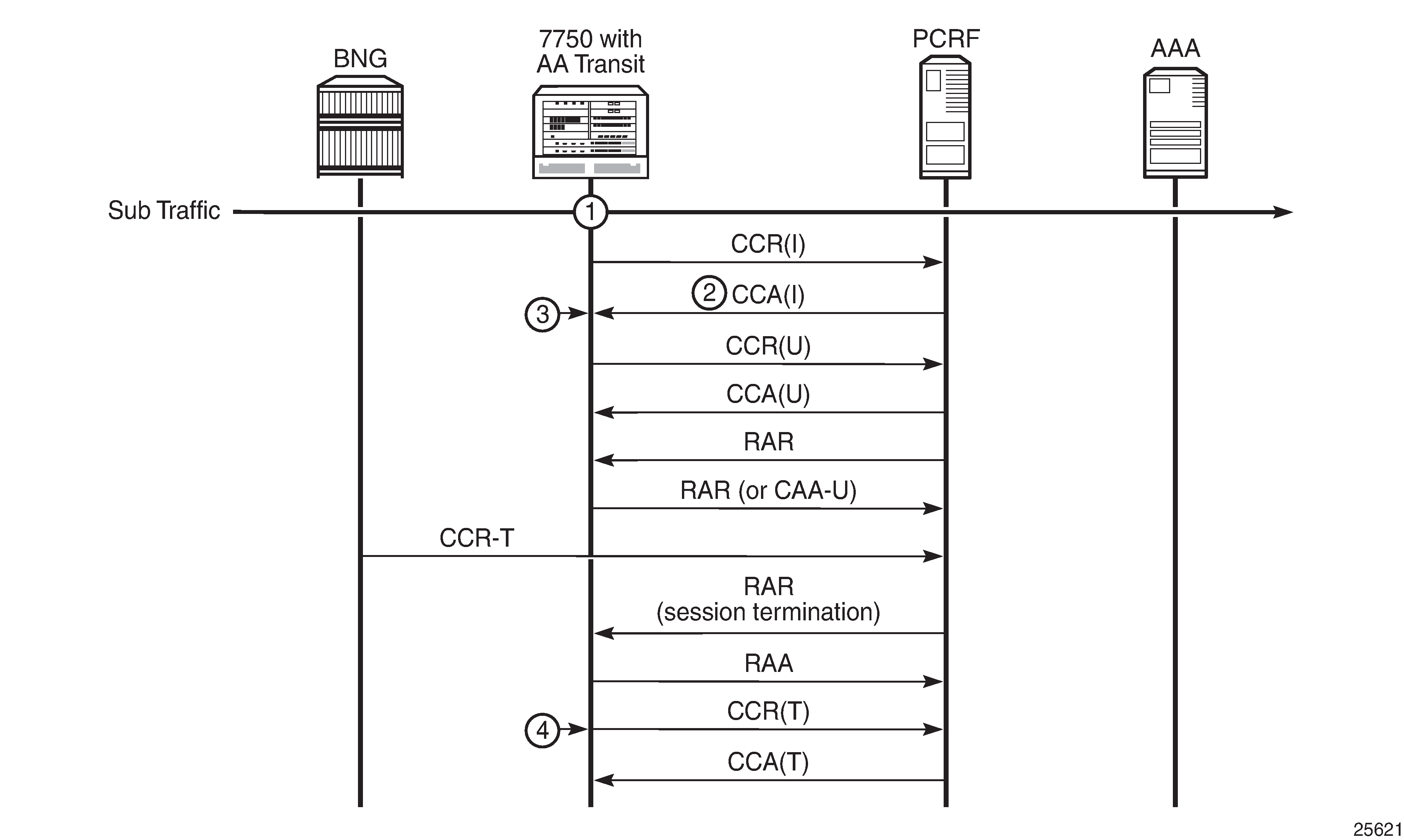For Diameter transit AA subscribers, AA auto-detects new IP addresses and notifies the PCRF of new subscribers via a Gx CCR-I message. The PCRF locates the subscriber’s AA policy and returns the information via CCA-I message to AA.
Figure: 3GPP pull model shows a 3GPP pull model, whereby AA initiates the Gx session. Table: 3GPP pull model description describes the figure. The PCRF can, at any time after the session is established, push new policies using a RAR message. New policies can include new usage-monitoring or AA ASO values.

| Legend | Description |
|---|---|
1 |
AA detects a new IP address, and sends a CCR-I containing the subscriber-side IP address |
2 |
CCA(I) contains subscriber AA policy information |
3 |
AA applies an AA appProfile, ASOs, and any AA usage monitoring |
4 |
AA reports usage counters for all specified or enabled usage monitoring keys, and removes the sub |
The CCR-I message from the 7750 SR node to PCRF contains the following:
session ID
subscriber-side IP address
IP-CAN-Type AVP (if enabled) with the value ‟tbc”
subscription ID AVP, with the following characteristics (if avp-subscription-id is configured as subscriber-id):
Type is END_USER_E164 (private by default)
ID is an auto-generated unique ID
Destination-Realm as configured in Diameter-Peer-Policy
Destination-Host if configured in Diameter-Peer-Policy
The CCA-I message from PCRF to the 7750 SR node contains the following:
session ID
Charging-Rule-Install containing the following information:
Charging-Rule-Definition ::=<AVP Header: 1003> {Charging-Rule-Name} [TDF-Application-Identifier] [Monitoring-Key] [AA-Functions {] AA profile AA-App-Service-Options { AA-App-Service-Options-Name AA-App-Service-Options-Value ........ [AVP]-
Charging-Rule-Name
-
Usage monitoring starts with ‟AA-UM:”
-
AppProfile and ASOs start with ‟AA-Functions:”
-
-
AA-Functions (AVPs to set AA profile and ASO values)
-
TDF-application-identifier; this field specifies a predefined AA charging group, application group, or application name for which usage monitoring functionality is required
Termination of the Gx session is only done after AA receives an RAR-T message from PCRF with the session-release-cause AVP meeting the configured threshold. After replying to an RAR message with an RAA message, AA sends a CCR-T message with reports of usage counters, if any are enabled.
Table: Used AVPs lists the AVPs used for Diameter transit AA subs.
| AVP | Category | Details | User configurable |
|---|---|---|---|
Session-Id |
M |
Globally unique Generated for each session as: <peer identity>;<high 32 bits>;<low 32 bits>;[<optional value>;]<subscriber ip> |
N |
Origin-Host |
M |
Configurable under aaa>diameter-peer-policy |
Y |
Origin-Realm |
M |
Configurable under aaa>diameter-peer-policy |
Y |
Destination-Realm |
M |
Configurable under aaa>diameter-peer-policy |
Y |
Auth-Application-Id |
M |
Set as Gx (16777238) |
N |
CC-Request-Type |
M |
Set to INITIAL_REQUEST (1) when initiating a new session Set to TERMINATION_REQUEST (3) when ending a session Set to UPDATE_REQUEST (2) in all other situations |
N |
CC-Request-Number |
M |
Generated internally according to Gx specifications Request numbering starts at 0 |
N |
Subscription-Id |
M |
Configurable using Subscription-Id-Type and Subscription-Id-Data |
— |
Subscription-Id-Type |
M |
Configurable under subscriber-mgmt>diameter-application-policy>gx>avp-subscriber-id origin |
Y |
Subscription-Id-Data |
M |
Configurable under subscriber-mgmt>diameter-application-policy>gx>avp-subscriber-id origin [type type] |
Y |
Framed-IP-Address |
M |
Set to the subscriber’s IP address as seen by AA-ISA in the from-sub direction of the data traffic |
N |
When the Subscription-Id-Type is ‟Subname”, then Subscription-Id-Data is auto-generated by AA to be unique node-wide, using the transit IP policy, SAP, and sub IP address.
Unlike AA ESM Diameter-controlled subscribers, transit Gx AA subscribers are not required to support ADC rules over Gx.
Transit Gx AA subscribers use PCC rules as per ESM Diameter AA subscriber implementation, and therefore uses AA-Function AVP.
For transit Gx AA subs, similarly to ESM Gx-controlled subs, the PCRF can set the subID in a CCR-I by sending a PCC rule with the name of the charging rule prefixed with ‟sub-id:”. The AVP appears as follows:
charging-rule-install (1001) VM------ [44]
vendor-id TGPP
data [32] (Grouped)
charging-rule-name (1005) VM------ [30]
vendor-id TGPP
data [18] (UTF8String) : Sub-Id:subID-name
In addition to using the AA Function AVP, AA supports the configuration of the application profile and ASOs by the PCRF via a CCR-I, CCR-U, or RAR that has PCC rules with the name of the charging rule prefixed with ‟AA-Functions:App:” or ‟AA-Functions:ASO”, such as:
charging_rule_install[0].charging_rule_name[0] = AA-Functions:App:<name>
charging_rule_install[0].charging_rule_name[1] = AA-Functions:Aso:<char>:<val>
...
charging_rule_install[0].charging_rule_name[n] = AA-Functions:Aso:<char>:<val>
AA allows for the definition of up to 32 ASOs. If the number of ASOs is larger than what can fit within a single charging-rule-install AVP, multiple charging-rule-install AVPs can be used in the CCR-I message.
As the Gx protocol is already supported by the 7750 SR/VSR system, there are no new configurations required. All existing configurations introduced to support ESM Gx control on a BNG can be re-used in AA transit deployment.